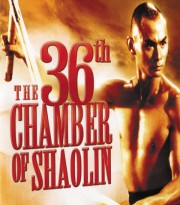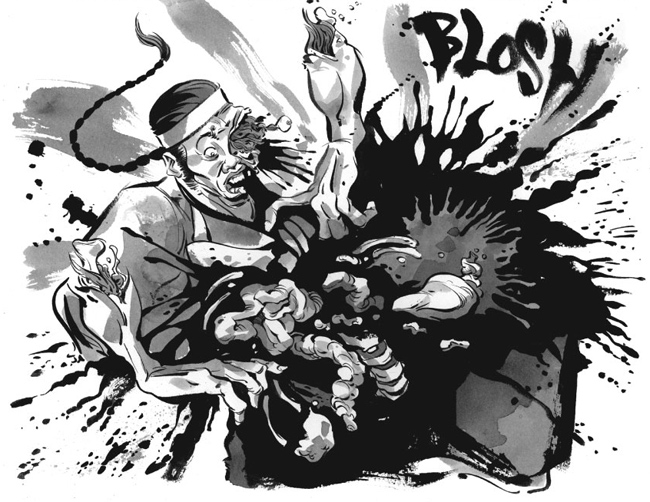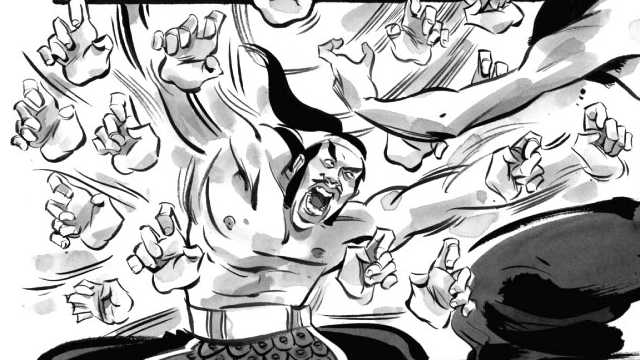Interview with Kagan McLeod
Pedro Monje (P.M.): Hello, Kagan. Let`s talk about your Infinite Kung Fu. For all of those who have not read it yet, what is this graphic novel about?
Kagan McLeod: Martial masters working to fix the ‘great balance’ after Buddhist reincarnation has gone awry, in an epic fantasy reflecting ’70s kung fu films in tone!
P.M.: Infinite Kung Fu is filled with zombies, instruction time, immortals, hidden treasures, resurrections, body-exchanges, chamber of brutal beasts, apocalyptic, magic, big swords, flying-limbs, robots, betrayal, lizards, too much adrenaline and, of course, a lot of kung-fu. Was it funny to mix all these traits all-in-one without losing the voice of the real protagonist of the story, making us care about him?
Kagan McLeod: I think it had more to do with being young and inexperienced — I crammed in everything I liked into one big tale and somehow it seemed to work. I might be too cynical now to try something with so many different elements. I like that it reflects my interests for a certain period of my life though.

P.M.: Before reading this comic, I was reluctant to see how the action of martial arts would be drawn in a medium as static as comics. However, all the fights and, above all, the last one are an EPIC WIN. And, taking into account the high number of characters, I can imagine it was a big task.
Kagan McLeod: Thank you! I like a challenge like that, translating something familiar in one medium to another. I guess my main idea for the fights in this book was to try to make the reader feel like they weren’t missing much between the panels. Like they were witnessing each move in succession, especially for the climax.

P.M.: I was delighted at the amount of gore, blood violence and bloodshed shown in the fights (skeletons used as weapons, yessss). This violence is never excessive and the fact that is in black and white makes it more digestible for weak-minds. Did you want expressly to use this amount of violence?
Kagan McLeod: I did! I think the tone of the book is very fun, so the violence is more wacky than unsettling. The Shaw brother’s movies of the ’70s and ’80s were pretty violent for the time, from people maimed in Crippled Avengers to punching straight through someone in Kid with the Golden Arm, or heads ripped off in Flying Guillotine. It was in that spirit that I went for the guts.
P.M.: Much as walking zombies are in fashion nowadays, Kung-Fu was also a trending topic in its golden days (we have to go back to the seventies, though). However, you were not born until later. How did you discovered and loved this genre?
Kagan McLeod: I’m sure it had a lot to do with Wu-Tang Clan’s first album in ’93. After that I started buying bootleg VHS tapes through my local video store. The thrill of the hunt was a huge part of it. Finding something really obscure and weird that nobody else knew about was a blast. It’s so easy now online to get whatever you want instantly, that it’s hard to imagine appreciating waiting 8 weeks for a clunky VHS tape with only a few good scenes on it.
I’ve always had a sore spot for so-bad-it’s-good material, and there’s a lot of that in martial arts movies. But for the higher quality films, obviously the choreography is impressive but I’m drawn to the ideas behind the fights. The characters are superheroes, but not mutants or aliens — just guys who became really powerful through hard work. The training is often just as exciting as the final fight.



P.M.: One question, that we are sure you may have answered lots of times, that we would like to make (as we have many followers who like this genre) is regarding your influences and favorites kung-fu stories. What are your favorite movies, books, comics, videogames, tv series…?
Kagan McLeod: Gordon Liu is a favourite so I was amazed to have him write a blurb for the introduction. I love his ‘monk’ movies — The 36 Chambers of Shaolin, Eight Diagram Pole Fighter, etc. Master of the Flying Guillotine is great, and Shaolin Executioner. I also love the 6 Lone Wolf and Cub films and the whole kung fu subgenre of Black Magic horror movies, like Boxer’s Omen, Black Magic (1 and 2) and Black Magic with Buddha. The Lone Wolf and Cub comics are also favourites of mine. An author named Louis Cha wrote some great martial arts novels that I really enjoy.



P.M.: Nevertheless, since you started publishing new attempts have been done to revive the genre. The most obvious are Kung-Fu Panda (though is a kids’ movie) and, of course, Kill Bill (even Matrix a little bit). And let’s not forget about Ed Brubaker and Matt Fraction’s take on Immortal Iron Fist. What do you think about all these (and others) new attempts to seduce new the generations?
Kagan McLeod: It’s great. Anything that opens up a genre or subject to a new audience is a plus. Smart people always like to go back and check out the source material which is good for everybody. You’ll get more references, and jokes.
P.M.: Did your documentation and investigation go any further than that? You know: kung-fu manuals, special lessons…
Kagan McLeod: No, nothing like that, though that would have been great for interviews.

P.M.: Our readers must know that you started self-publishing Infinite Kung Fu in 2000 and you finished publishing it (with Top Shelf Productions) in 2011, adding 200 more pages to the story. That’s twelve years of your live. How have you seen the evolution of this project along all these years? Did your ideas change from what you had planned at the beginning? How was finishing something in your 30s that you started way back in your 20s?
Kagan McLeod: Yes, totally. You might be able to see within the story that I kind of reigned in the wild world I’d created a bit. It was exploding in so many directions I tried to steer it and simplify it to focus on kung fu and not the other genres. I kept in all the stuff I wrote in the early years, but wrote my way out of the bits I didn’t like as much. For instance, Moog’s limb regeneration power is cool, but I wanted to tone it down because I didn’t want the other character’s powers to be so fantastic. So I came up with the backstory of him drinking an elixir and learning the technique from a lizard. I definitely got distracted for many of those 12 years, but always enjoyed working on the book when I did.
P.M.: We would like also to talk about your style, very dynamic and energetic, and changing the thickness of the line in flashback sequences. We know that you do your own inking? What is the process you follow to finish a page?
Kagan McLeod: Thanks. I love Chinese traditional drawing, and the influence was appropriate for the subject matter. I’m always happy (especially for a kung fu book) when people describe my drawings as dynamic and fluid, I really strive for those qualities. I like to keep my pencils very loose so I don’t take all the fun out of inking. A lot of times I do big ragged brush strokes first, because those are where I’m most likely to make a mistake, and if those go well I go in for the details. The ink wash was a lot more fun for me to do than working digital, and I think it also worked well for the subject matter.
P.M.: It brought to my attention that you hardly decide to use big splash-pages in your 464-page graphic novel. Splash-page is an inherent evil of this medium, but you prefer to reduce it to the minimum (which is pleasant) and fill the pages with many panels. Was this a conscientious choice?
Kagan McLeod: Right, so that when you do get to a splash page it’s more meaningful. I think I learned that from Watchmen.

P.M.: A mandatory question (I’m also sure that you may have answered many times), is to ask you about how did you get the great Gordon Liu, known for example for his roles in «Kill Bill,» to write an introduction for the book?
Kagan McLeod: Colin Geddes, a friend of mine who works for the Toronto International Film Festival and is very connected to a lot of film people. At some point Gordon was in Toronto for a few screenings of some of his films, and Colin couldn’t make it to a dim sum with him arranged by the Hong Kong Trade Office. He graciously gave me his spot, and even being the only non-cantonese speaking gweilo in the room I still managed to snag the seat next to Mr. Liu. He’s a great guy, and I put the bug in his ear about the foreward then. Another friend, King Wei Chu of the Montreal Fantasia Festival, helped me get in touch with Gordon later on.
P.M.: Also, given the world in which we live know, we must ask the following question. Is there any working plan to bring Infinite Kung Fu to the big screen? Moog Joogular throwing his own head at ninja-zombies will be awesome.
Kagan McLeod: There have been a few film options here and there over the years but nothing’s materialized yet. Maybe they could make it in Spain as a future Rec sequel!
P.M.: Before concluding, we would not like to miss the opportunity to ask you about your next projects? What are you working nowadays? Could you give as some details?
Kagan McLeod: Well hopefully this will be of special interest to your readers — the next book I’m doing is about the Spanish conquest of Mexico. Similar to Infinite Kung Fu in that it will have lots of action, adventure (and blood), but a bit more serious in tone. It will be another mega-project. I promise to keep you updated.
P.M.: Thank you very much. We wish you all the best and, in Zona Negativa, we will be following your work. And, of course, Happy New Year! Kind regards.









